Colombia 1: Into the Mountains
"Bogota to Murillo"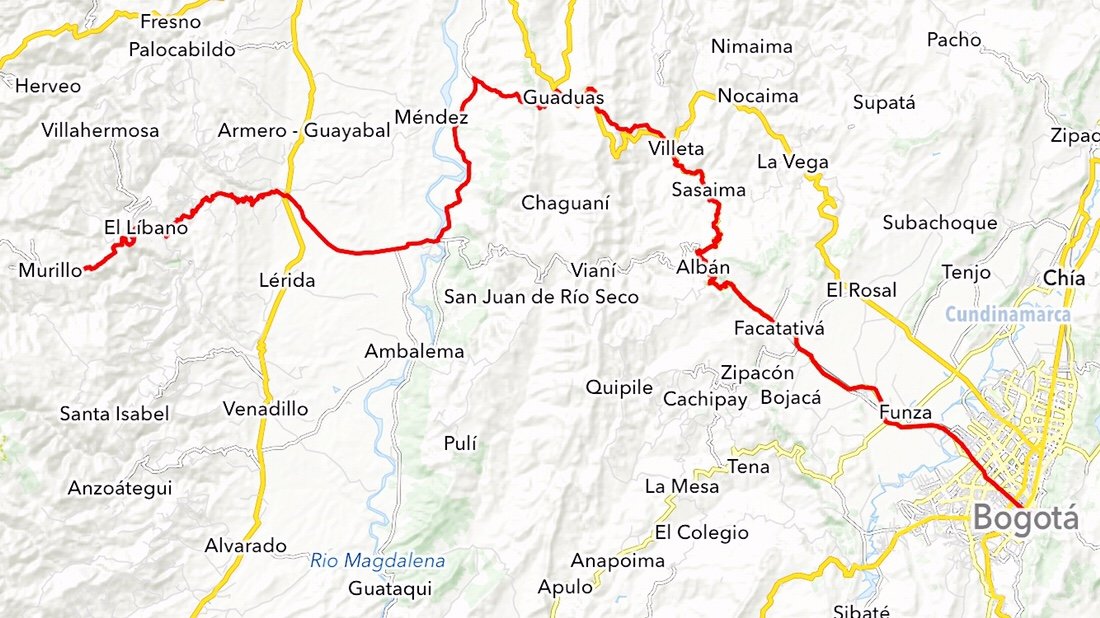 We arrived in Bogota exhausted from the long, overnight, layover in Mexico City, but our hostel was in a great location, surrounded by coffee shops and eateries with good vegetarian options, including a Lebanese restaurant.
We arrived in Bogota exhausted from the long, overnight, layover in Mexico City, but our hostel was in a great location, surrounded by coffee shops and eateries with good vegetarian options, including a Lebanese restaurant.
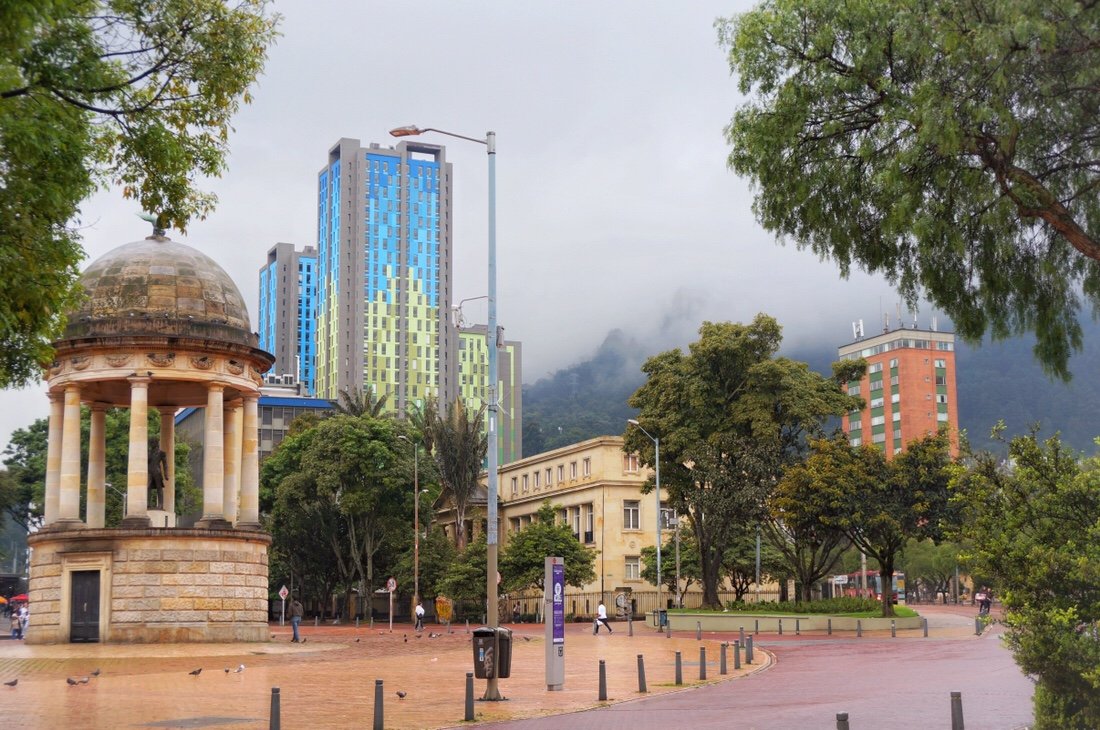 It only took a couple of interactions for me to realize that the Spanish here was different. It's fast with a different rhythm, and a little slurred together like French, making it so I can't understand most of what people say. It almost feels like I'm starting all over again.We spent a couple of days exploring the Candelaria district and its endless street art and murals before heading west into the mountains.
It only took a couple of interactions for me to realize that the Spanish here was different. It's fast with a different rhythm, and a little slurred together like French, making it so I can't understand most of what people say. It almost feels like I'm starting all over again.We spent a couple of days exploring the Candelaria district and its endless street art and murals before heading west into the mountains.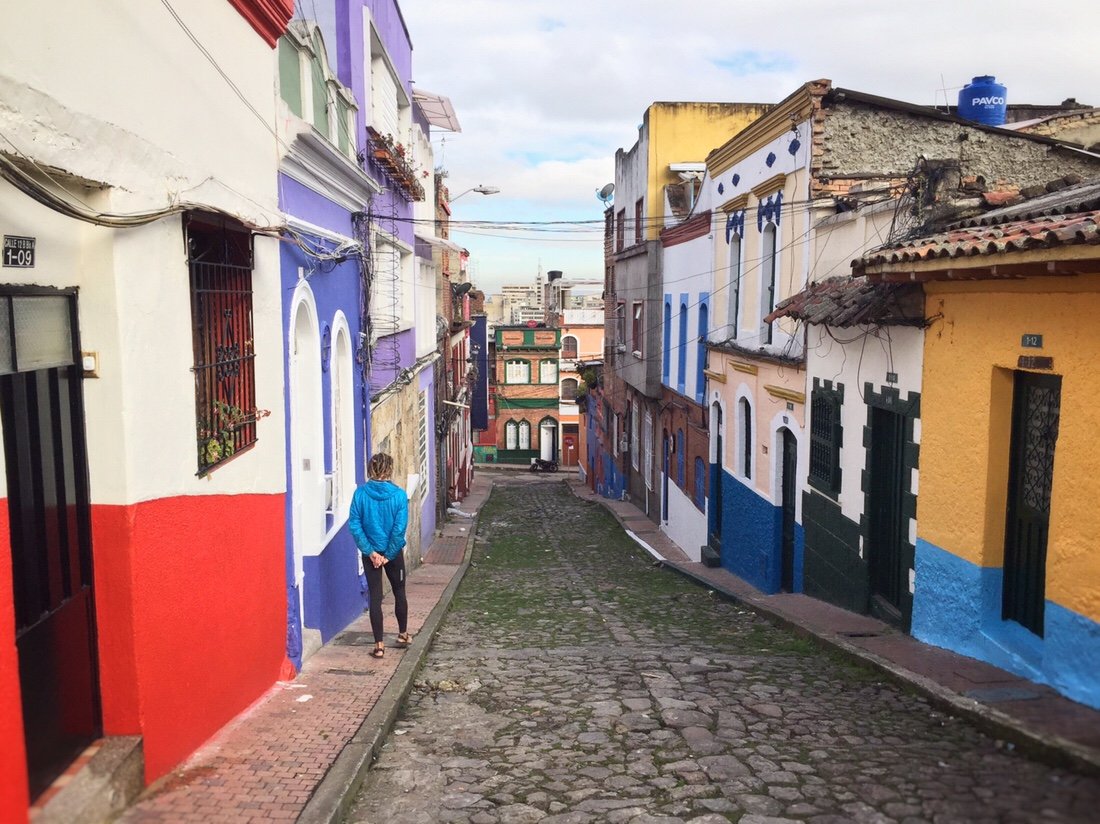


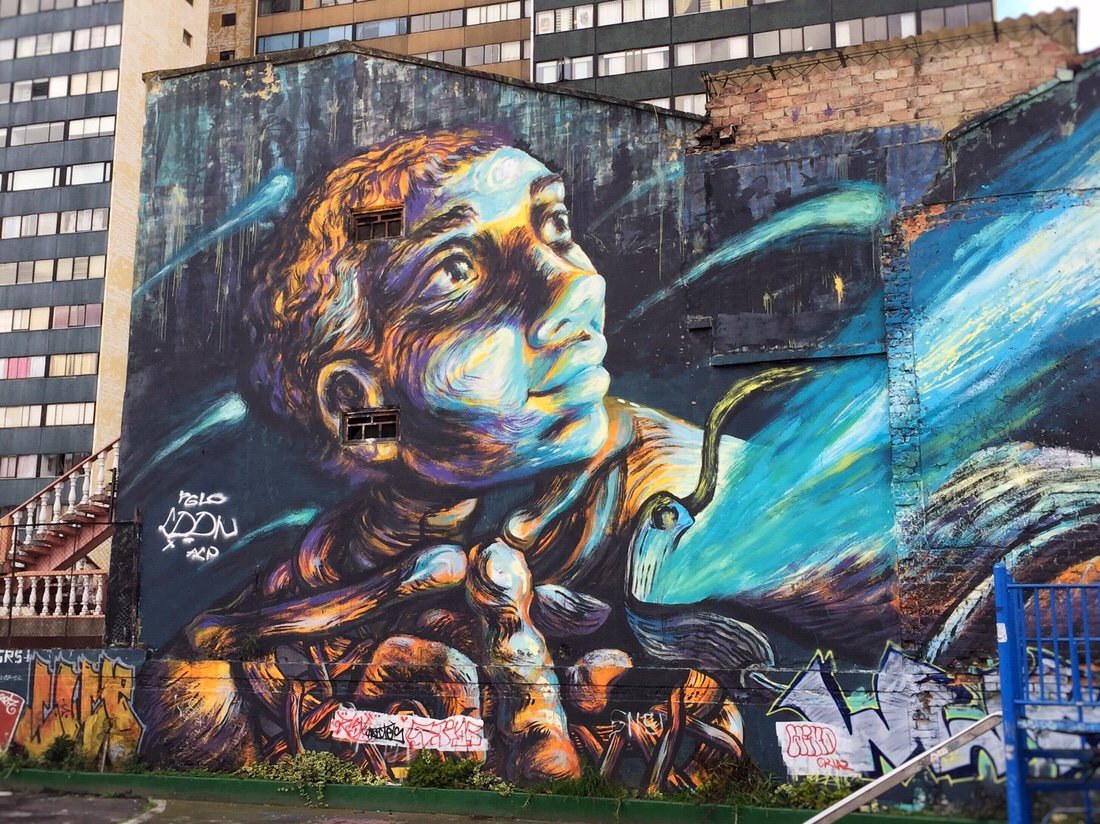
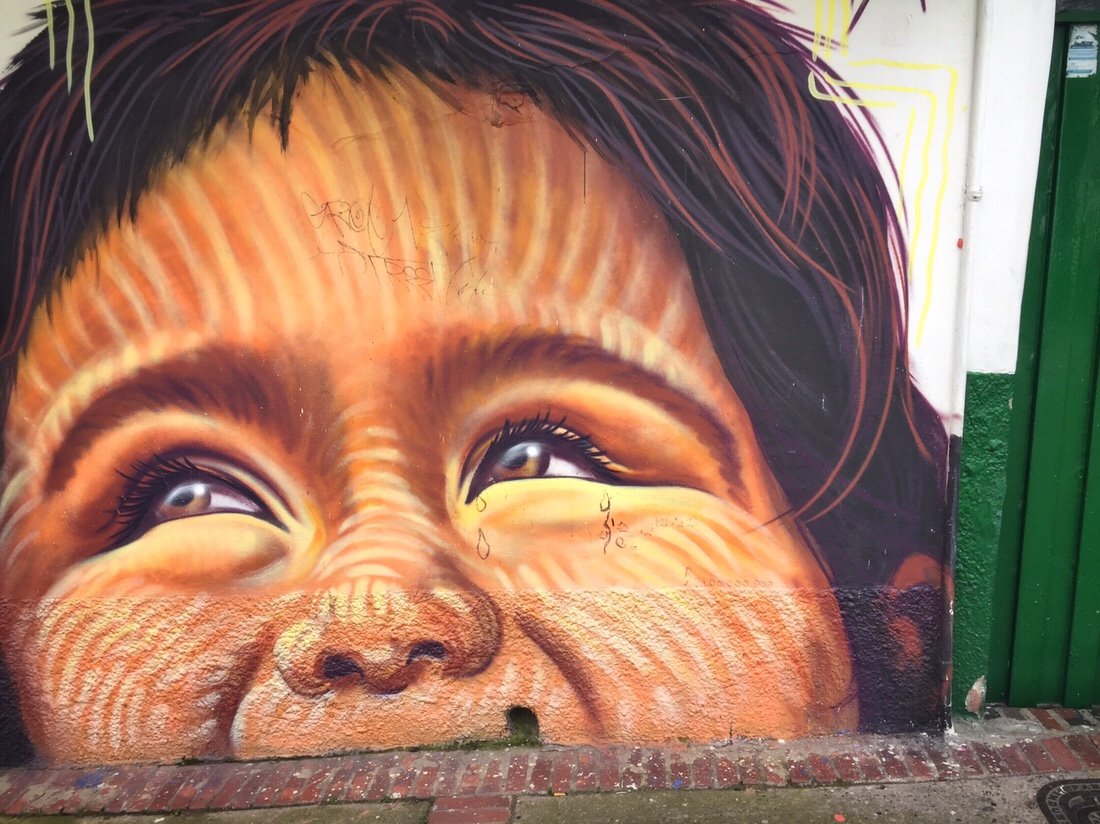
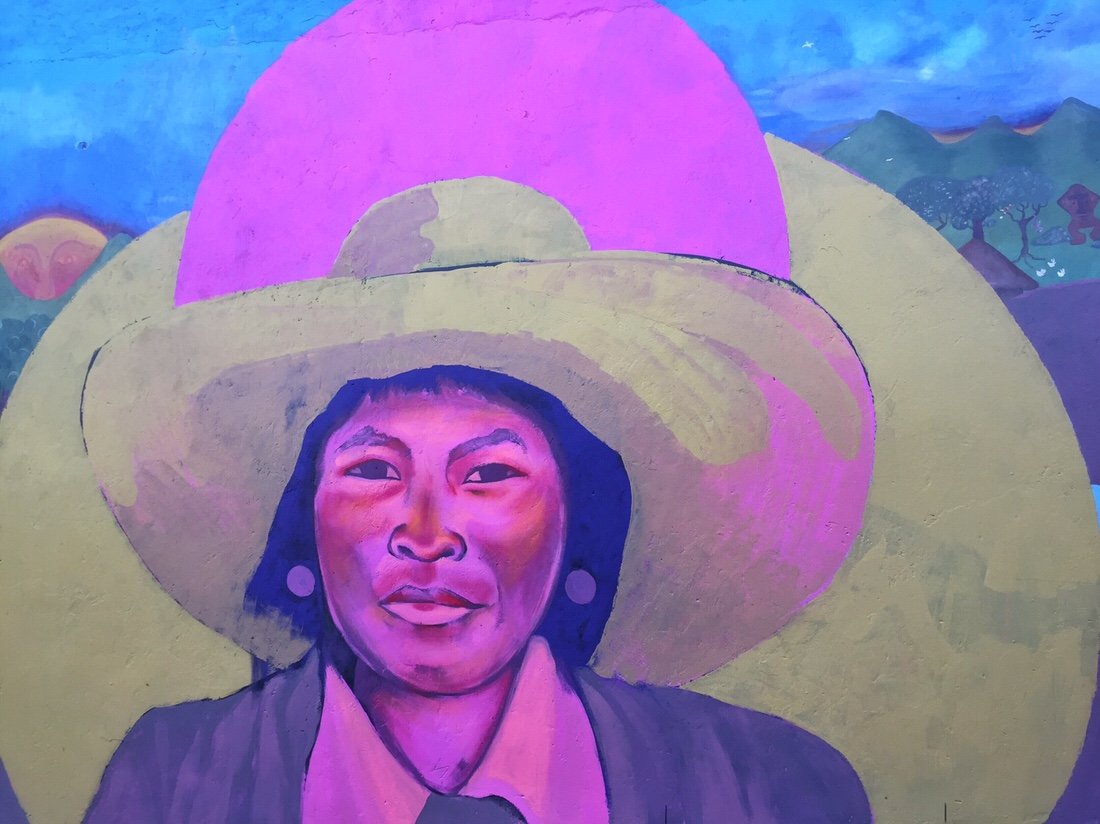 Before leaving Bogota we met up with two cyclists we had first met way back in Guanajuato, Mexico. We walked around the city, tried chicha, and exchanged the highs and lows of our journeys.[ you can find them on instagram at: instagram.com/enjoyingtherides ]
Before leaving Bogota we met up with two cyclists we had first met way back in Guanajuato, Mexico. We walked around the city, tried chicha, and exchanged the highs and lows of our journeys.[ you can find them on instagram at: instagram.com/enjoyingtherides ]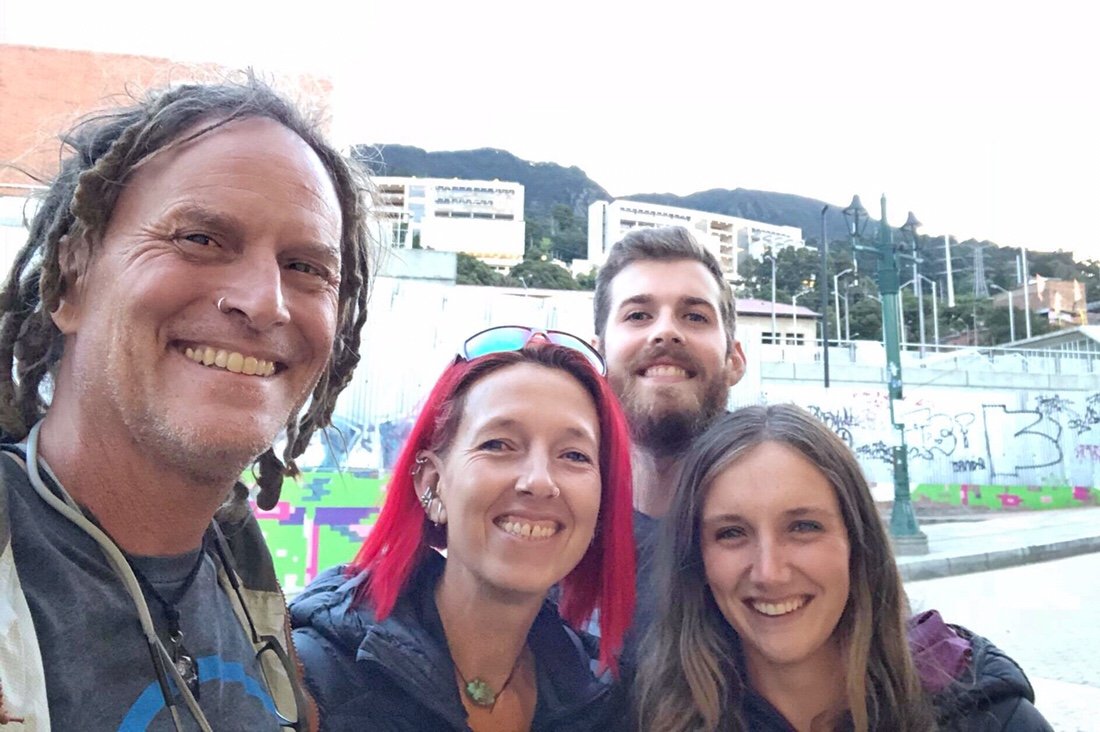
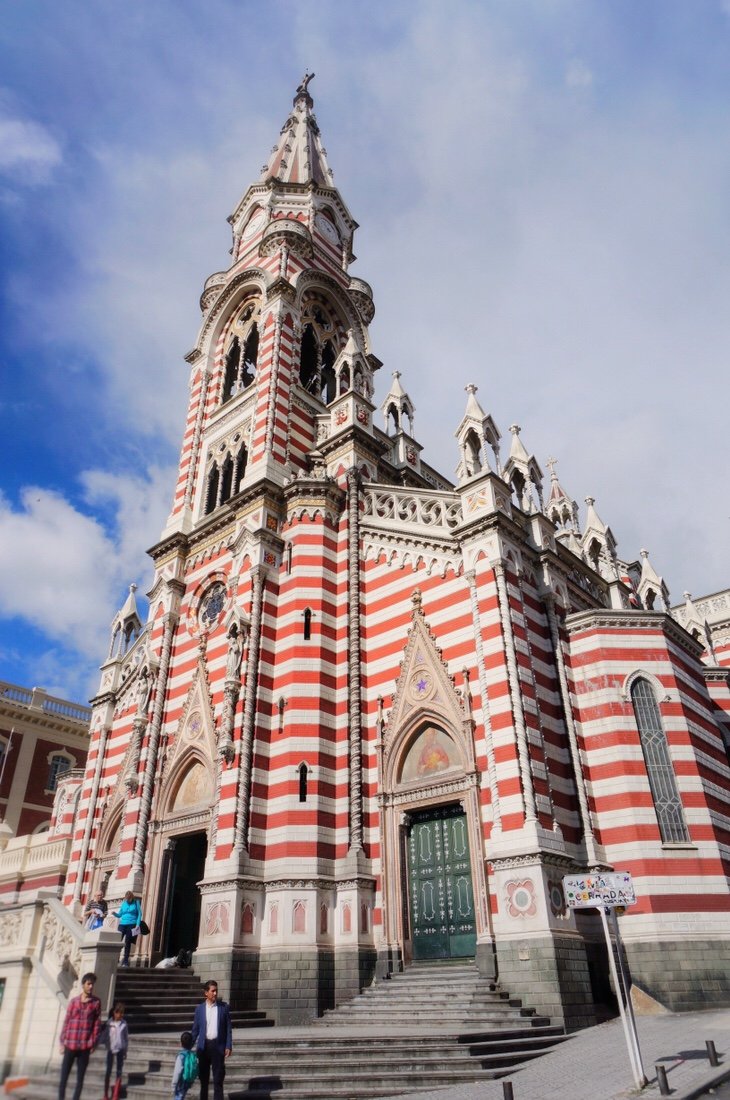 The ride out of Bogota wasn’t too bad. The outskirts of the city are crowded, but all the cars, trucks, buses, motorcycles, and bicycles all seemed to flow in a chaotic knot of traffic that worked.
The ride out of Bogota wasn’t too bad. The outskirts of the city are crowded, but all the cars, trucks, buses, motorcycles, and bicycles all seemed to flow in a chaotic knot of traffic that worked. When we got further from the city, the highway turned into a divided toll highway, but motorcycles and bicycles were exempt from the toll and had free passage through a dedicated narrow lane on the far right, marked for “motos y bicis exclusivo”.
When we got further from the city, the highway turned into a divided toll highway, but motorcycles and bicycles were exempt from the toll and had free passage through a dedicated narrow lane on the far right, marked for “motos y bicis exclusivo”.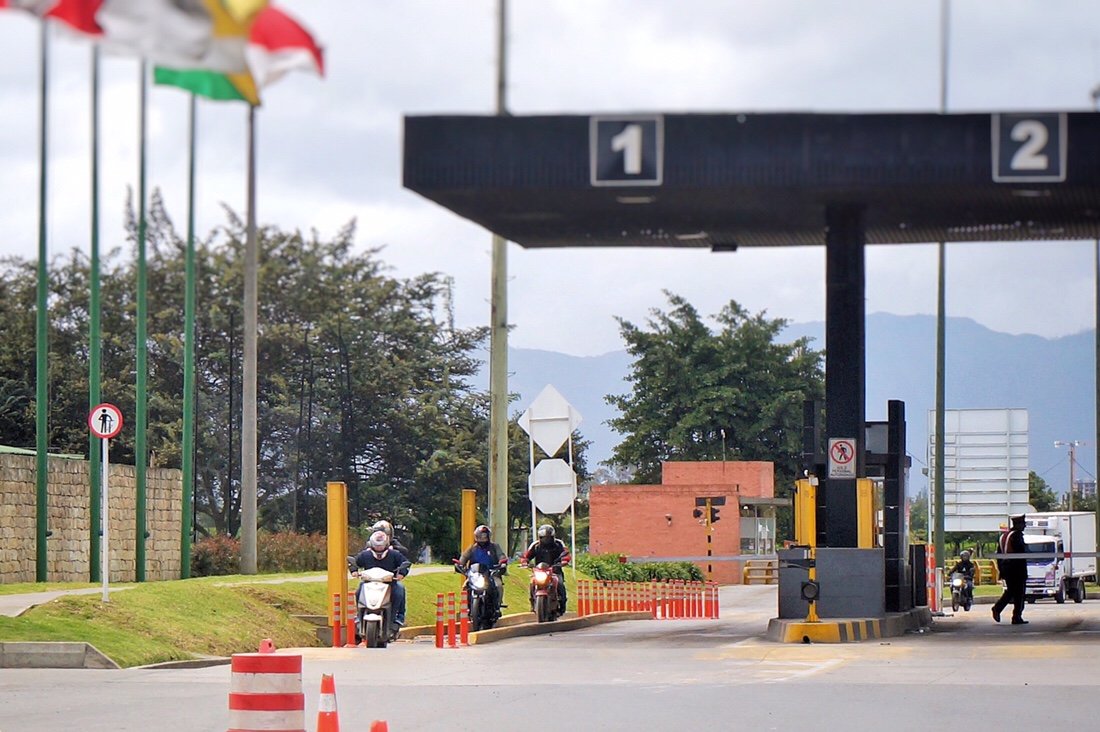 After riding on the toll road for a few kilometers, a two-way bicycle and pedestrian only paved path bordered the highway, which we followed for nearly ~10 kilometers before arriving in Facatativá.So far, the food in Colombia is very different than in Mexico. It usually includes patacon (fried plantains/bananas), rice, arepa (a small, thick, corn patty/cake) and meat, though it seems there is often a veggie option if you ask.
After riding on the toll road for a few kilometers, a two-way bicycle and pedestrian only paved path bordered the highway, which we followed for nearly ~10 kilometers before arriving in Facatativá.So far, the food in Colombia is very different than in Mexico. It usually includes patacon (fried plantains/bananas), rice, arepa (a small, thick, corn patty/cake) and meat, though it seems there is often a veggie option if you ask. We stayed in Facatativá to visit Piedras del Tunjo Archeological Park. The park contains huge rock features and petroglyphs. Some of the rocks overhang and lean against each other so much that they form caves, which were inhabited by the Muisca people, I think around ~0 AD, but the information on site was a little unclear.
We stayed in Facatativá to visit Piedras del Tunjo Archeological Park. The park contains huge rock features and petroglyphs. Some of the rocks overhang and lean against each other so much that they form caves, which were inhabited by the Muisca people, I think around ~0 AD, but the information on site was a little unclear.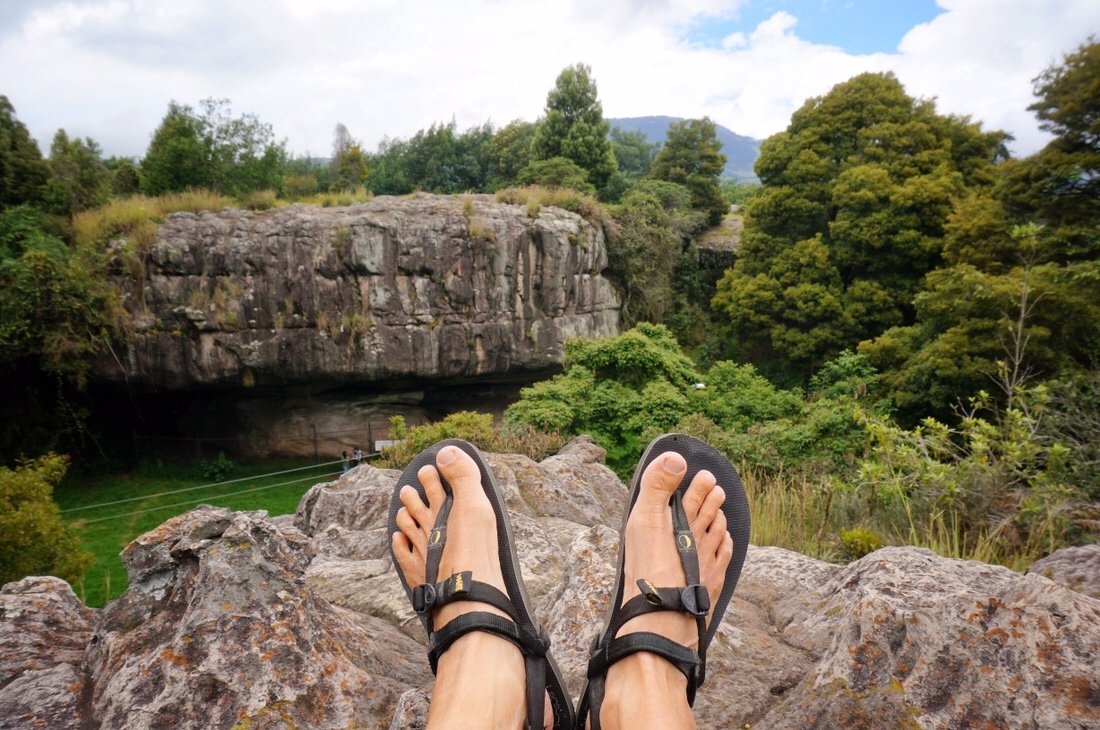 The sign said this petroglyph (below) had drawings of tobacco leaves.
The sign said this petroglyph (below) had drawings of tobacco leaves. ...and this one (below) was of an anthropomorphized frog.
...and this one (below) was of an anthropomorphized frog.



 On the walk back to our hotel, Neon bought some roasted corn. We were both surprised to see that the corn cob was pink. It was definitely the prettiest corn cob I've ever seen.
On the walk back to our hotel, Neon bought some roasted corn. We were both surprised to see that the corn cob was pink. It was definitely the prettiest corn cob I've ever seen.
 We found a place that said they had "ensalada de fruta" (fruit salad) so we ordered a couple. It did contain a lot of mixed fruits, but it was also an interesting layering of fruit mixed with cream, then layered with grated cheese, and then topped off with slices of fruit, a couple of pieces of cookie, and a scoop of ice cream. It seems to be a pretty common thing here as we've seen them offered in almost every town we've ridden through.
We found a place that said they had "ensalada de fruta" (fruit salad) so we ordered a couple. It did contain a lot of mixed fruits, but it was also an interesting layering of fruit mixed with cream, then layered with grated cheese, and then topped off with slices of fruit, a couple of pieces of cookie, and a scoop of ice cream. It seems to be a pretty common thing here as we've seen them offered in almost every town we've ridden through.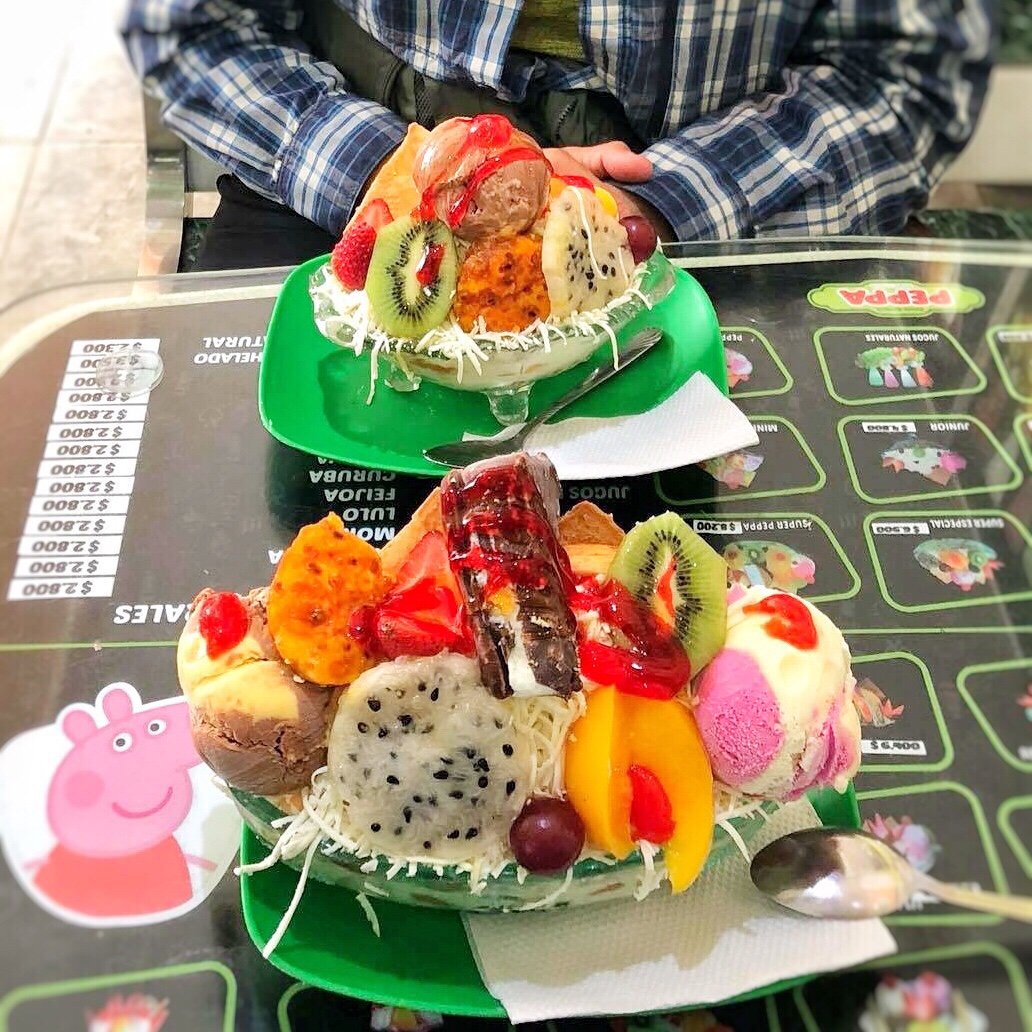 Our plan for the next day was to ride a historic camino out of Facatativá, the Camino Real Honda - Santafé de Bogotá, an old trade route that linked Bogota to the Magdalena River at Honda. But most of the old road didn’t seem to exist anymore, having become unused overgrown train tracks, a line of big power lines, or simply built over with buildings so we continued on the highway until we reached the town of Villeta, where the old camino was still in use.
Our plan for the next day was to ride a historic camino out of Facatativá, the Camino Real Honda - Santafé de Bogotá, an old trade route that linked Bogota to the Magdalena River at Honda. But most of the old road didn’t seem to exist anymore, having become unused overgrown train tracks, a line of big power lines, or simply built over with buildings so we continued on the highway until we reached the town of Villeta, where the old camino was still in use.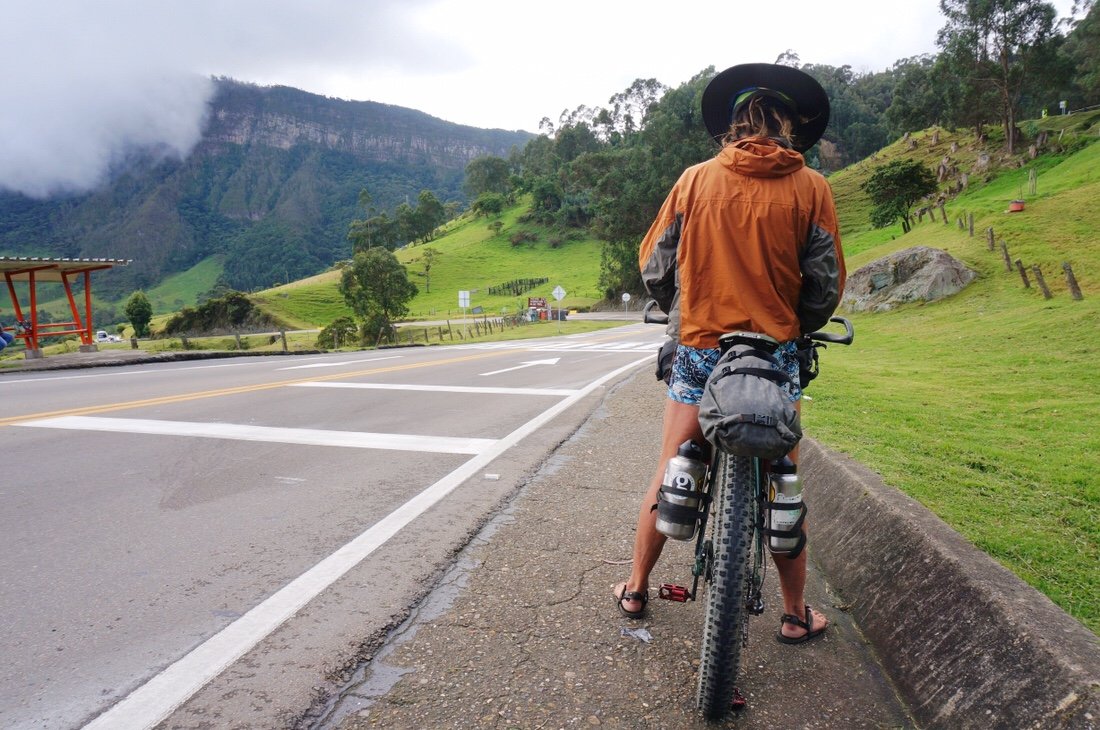 After turning onto a dirt road, the Camino Real Honda, we stopped at a creek crossing where the locals were swimming and cooling off from the heat of the day. It was too muggy and humid out for me, but Neon went in for a quick dip.
After turning onto a dirt road, the Camino Real Honda, we stopped at a creek crossing where the locals were swimming and cooling off from the heat of the day. It was too muggy and humid out for me, but Neon went in for a quick dip. Then we began a 1000 meter climb that turned out to be a six hour hike-a-bike. The old road was in good shape, but it was steep and relentless in its effort to ascend the old mountain pass. Just when I was at a low point in my desire to be here, we stopped for a break, I could see a family sitting not too far from us when one of the men walked down the road and handed us two cups full of “jugo de caña”. It was slightly sweet, and a bit fermented, and exactly what I needed to lift my spirits enough to tackle the rest of the climb. It turned out to be a sweet afternoon of bench-pressing our bikes up into the tropically-green mountainside, full of flowering trees, vines, banana trees, sugarcane and near the top—coffee plants as far as the eye could see.
Then we began a 1000 meter climb that turned out to be a six hour hike-a-bike. The old road was in good shape, but it was steep and relentless in its effort to ascend the old mountain pass. Just when I was at a low point in my desire to be here, we stopped for a break, I could see a family sitting not too far from us when one of the men walked down the road and handed us two cups full of “jugo de caña”. It was slightly sweet, and a bit fermented, and exactly what I needed to lift my spirits enough to tackle the rest of the climb. It turned out to be a sweet afternoon of bench-pressing our bikes up into the tropically-green mountainside, full of flowering trees, vines, banana trees, sugarcane and near the top—coffee plants as far as the eye could see. It was a long day but we made it to the next town, Guaduas, just as the sun was setting. It gets dark early here. The sun has been setting at ~6:00 pm, and it's dark by 7:00 pm.
It was a long day but we made it to the next town, Guaduas, just as the sun was setting. It gets dark early here. The sun has been setting at ~6:00 pm, and it's dark by 7:00 pm.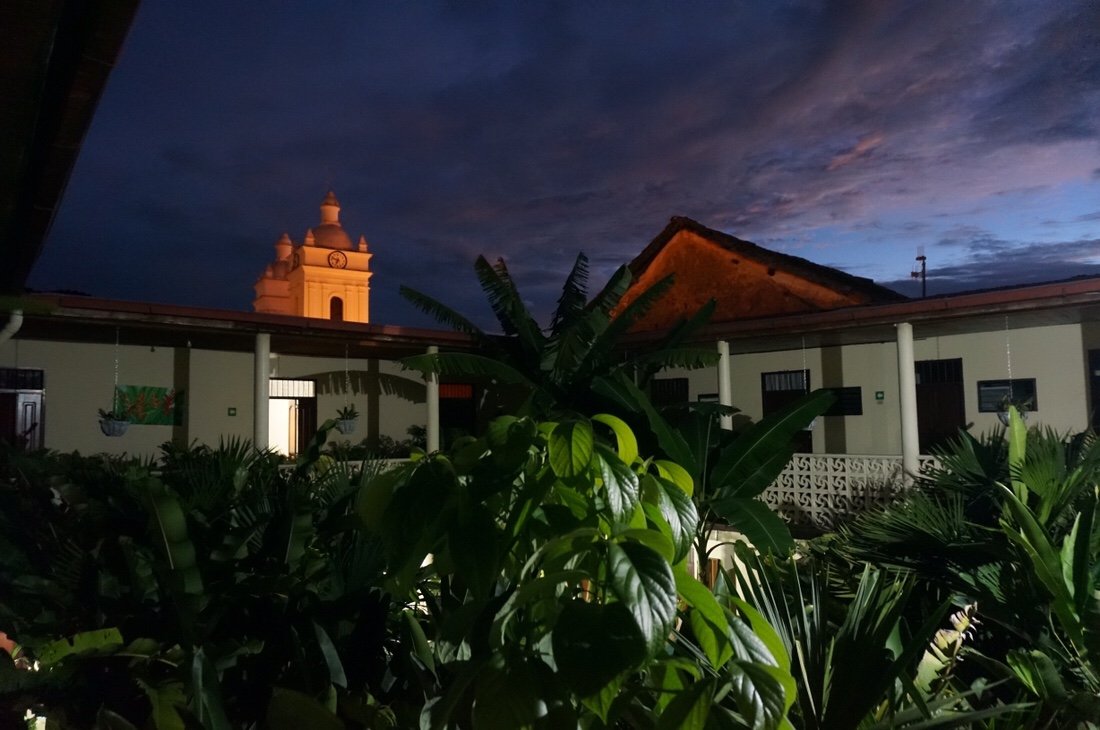 I've really been struck by Colombia. Many of the towns we've ridden through have that old world charm, like places I've been in Europe, complete with umbrella covered seating, outside the cafes. Some places still remind me more of places in Mexico, but others feel more like I'm off the beaten path somewhere in Italy.
I've really been struck by Colombia. Many of the towns we've ridden through have that old world charm, like places I've been in Europe, complete with umbrella covered seating, outside the cafes. Some places still remind me more of places in Mexico, but others feel more like I'm off the beaten path somewhere in Italy.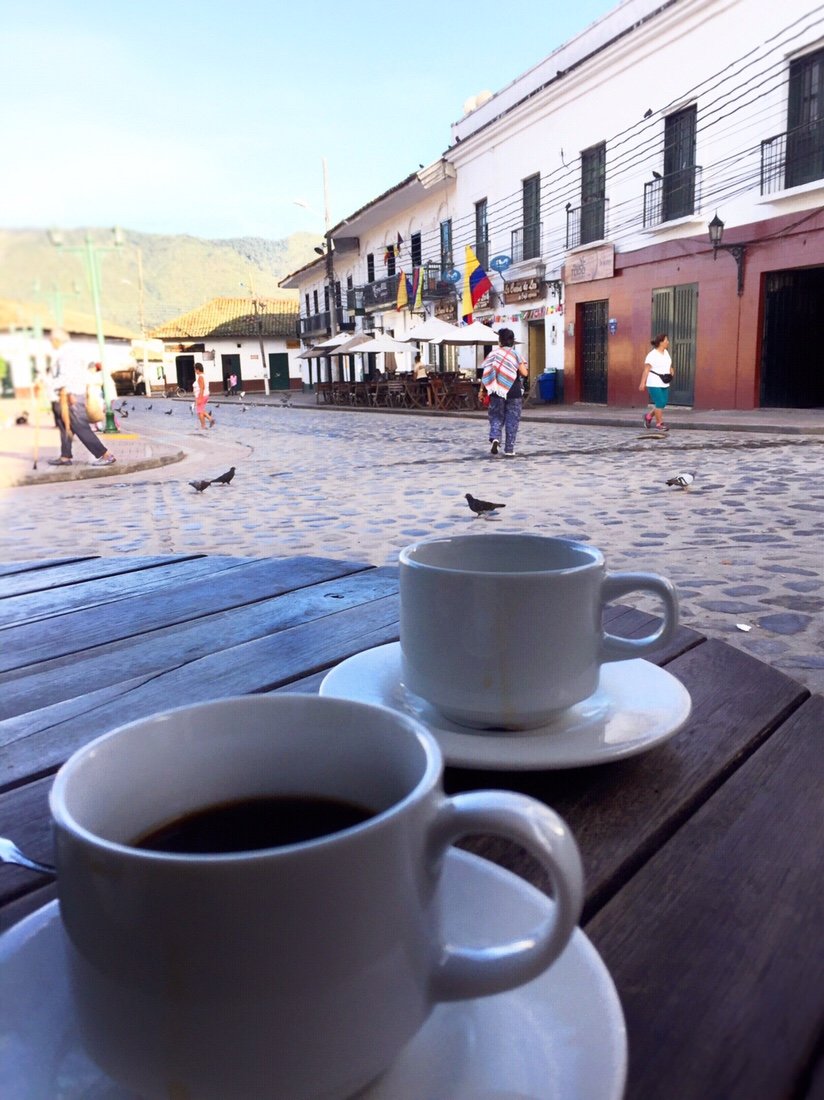
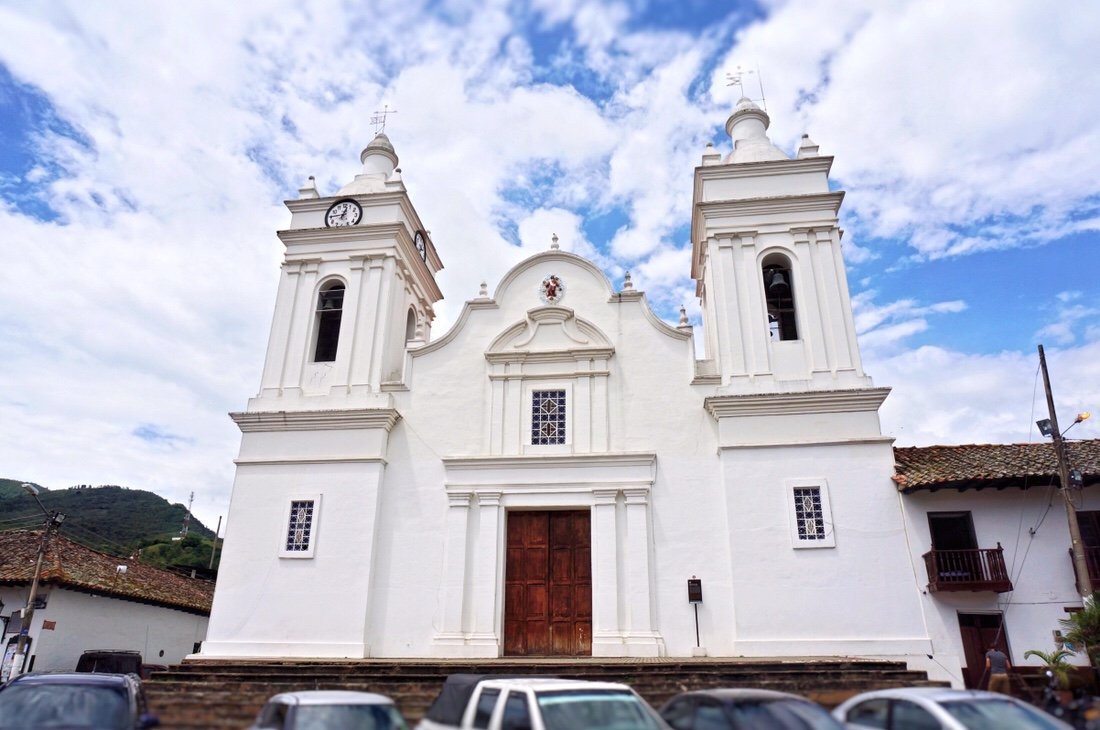 When all else fails, beans and rice are still a favorite for me, though beans are much less common here. I'm still trying find my groove with the food in Colombia. Some towns have great vegetarian options, but others have been a challenge.
When all else fails, beans and rice are still a favorite for me, though beans are much less common here. I'm still trying find my groove with the food in Colombia. Some towns have great vegetarian options, but others have been a challenge.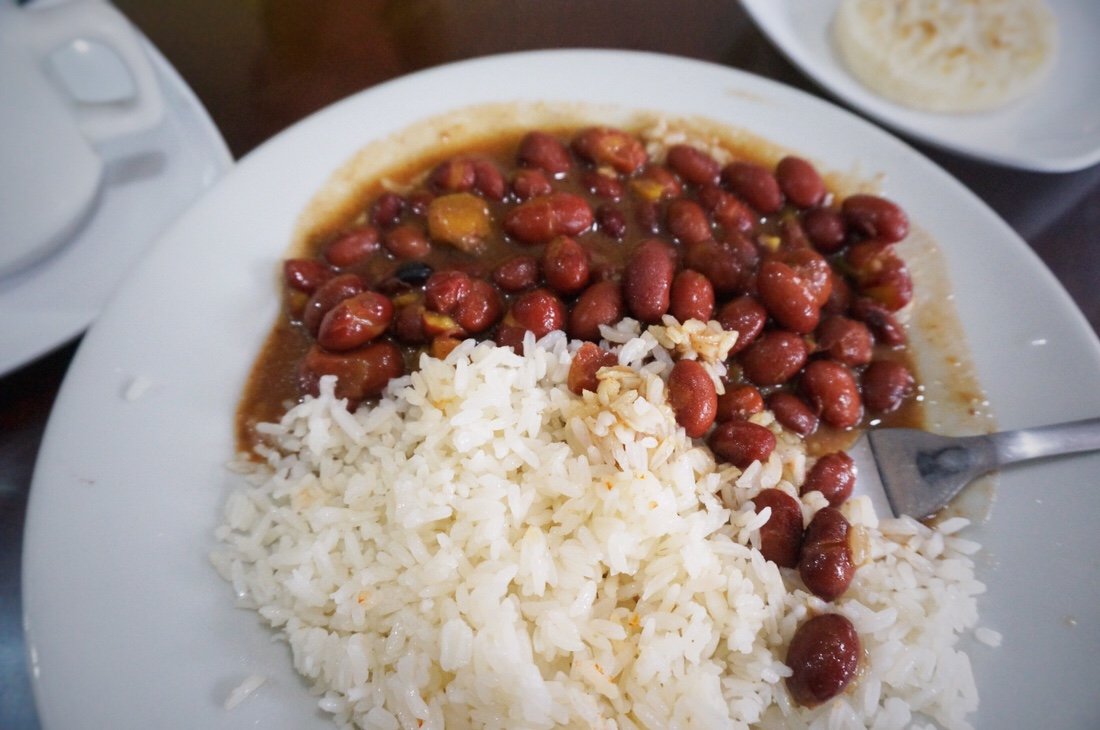 Shortly after leaving Guaduas we climbed over a ridge and got our first view of Nevado Ruiz, way out on the horizon, peeking through the clouds.
Shortly after leaving Guaduas we climbed over a ridge and got our first view of Nevado Ruiz, way out on the horizon, peeking through the clouds.
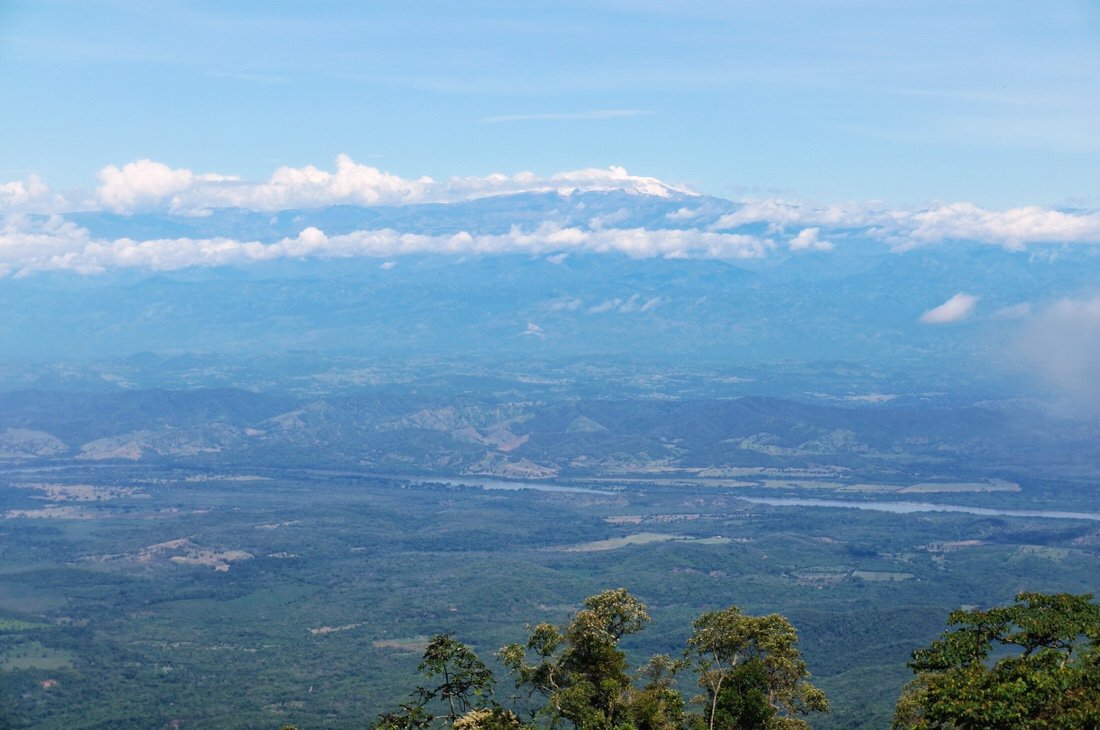 Down the other side we descended, steeply, into the Magdalena River valley where we were ~2500 meters lower than Bogota. It was much hotter, and a little drier too.
Down the other side we descended, steeply, into the Magdalena River valley where we were ~2500 meters lower than Bogota. It was much hotter, and a little drier too.
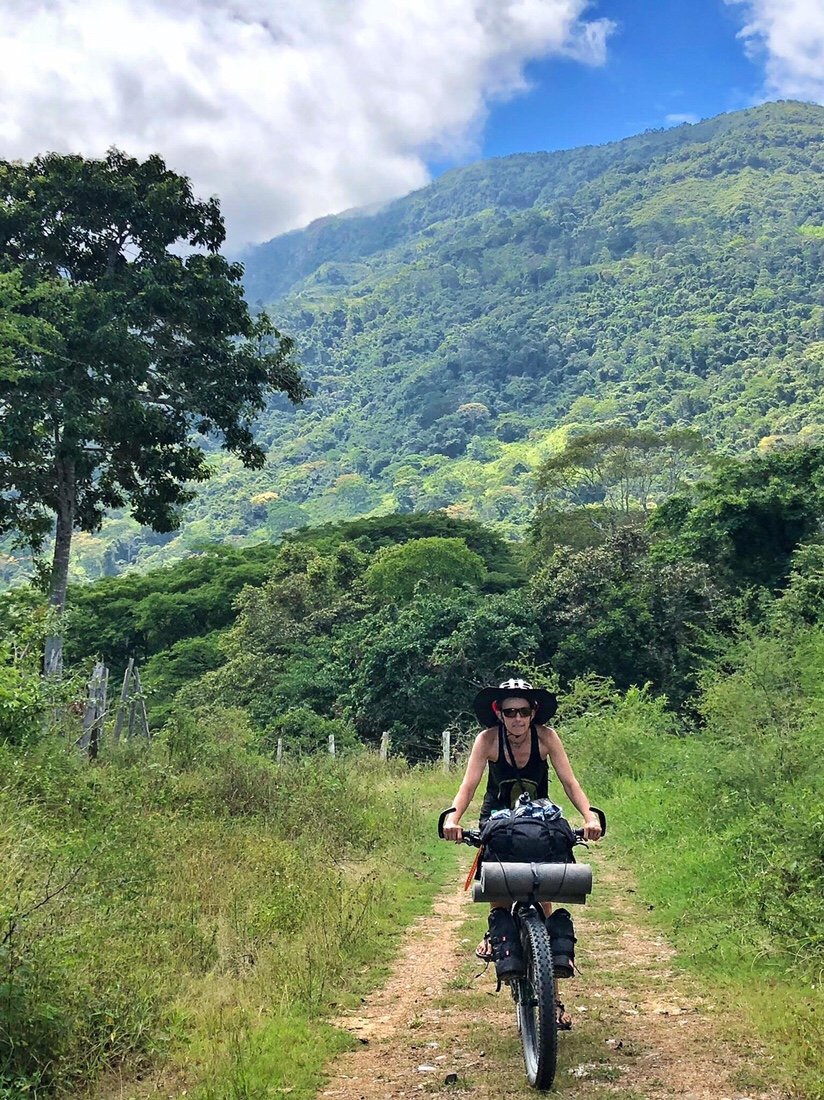
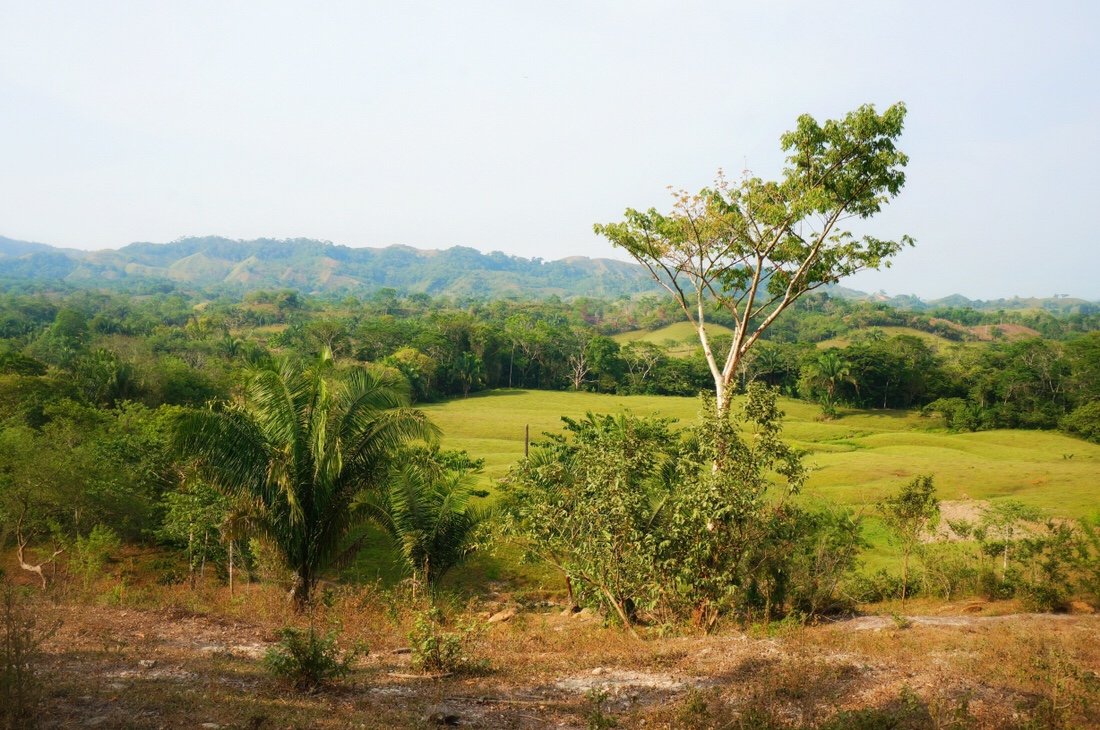
 Even though it was drier, it was still quite humid, and I was still dragging a bit from all our plane travels, so we cut the day short when we found a cheap hotel with a pool in Camboa.
Even though it was drier, it was still quite humid, and I was still dragging a bit from all our plane travels, so we cut the day short when we found a cheap hotel with a pool in Camboa.
 The next day we crossed the Magdalena River and began the ~4000 meter climb up towards Nevado Ruiz.
The next day we crossed the Magdalena River and began the ~4000 meter climb up towards Nevado Ruiz.

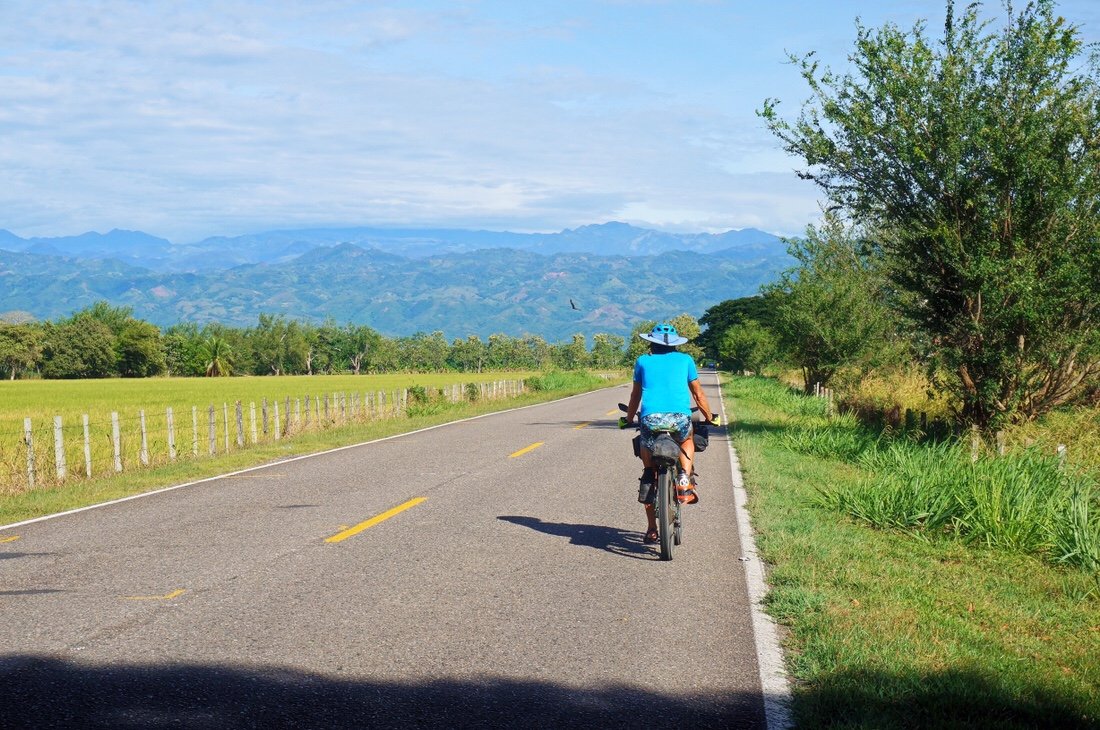 We spent the night at an ecotourist farm in Padillo. We both had our first taste of fresh sugar cane. It's much more juicy than I imagined, and though quite sweet, it's not as sugary sweet as I thought it would be.
We spent the night at an ecotourist farm in Padillo. We both had our first taste of fresh sugar cane. It's much more juicy than I imagined, and though quite sweet, it's not as sugary sweet as I thought it would be.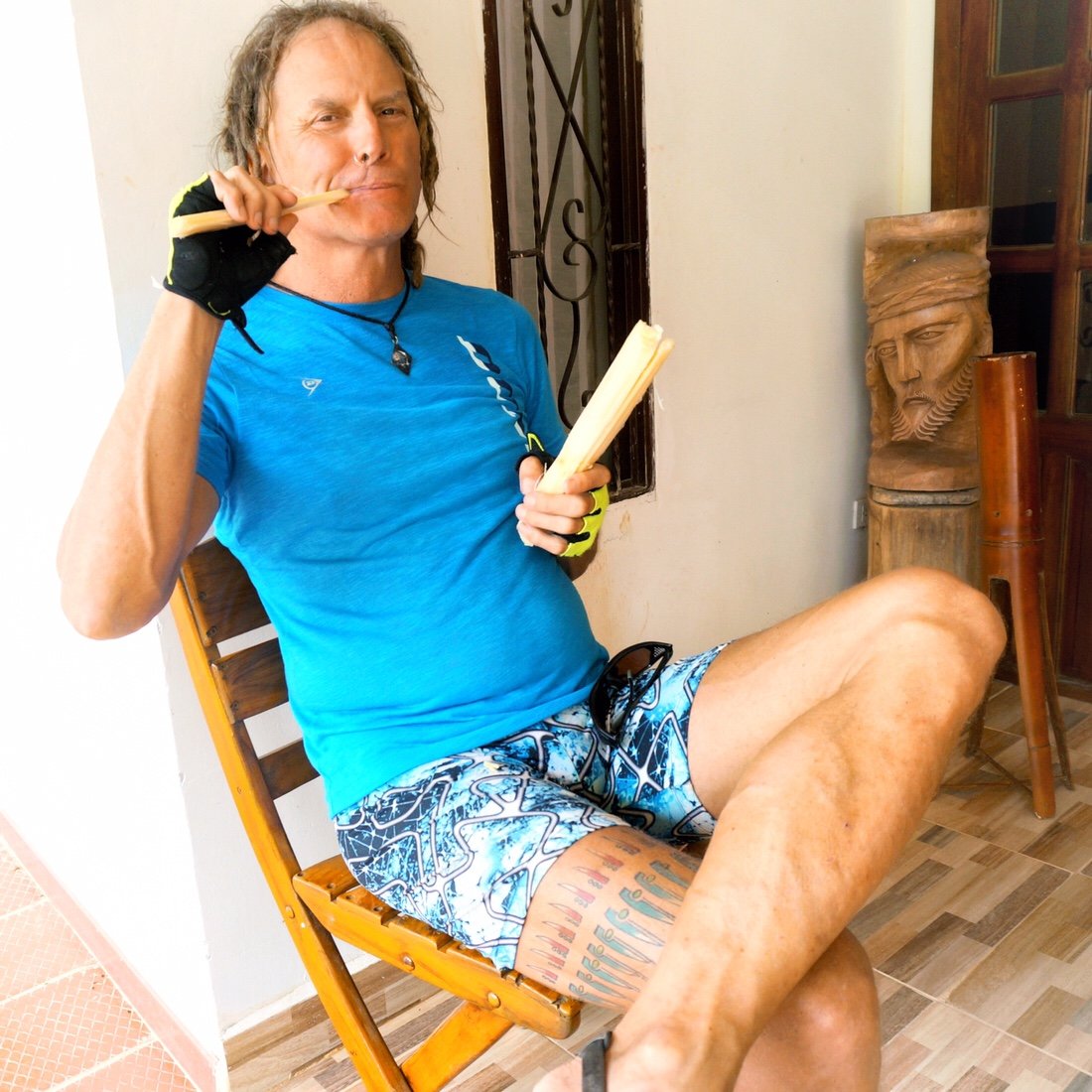
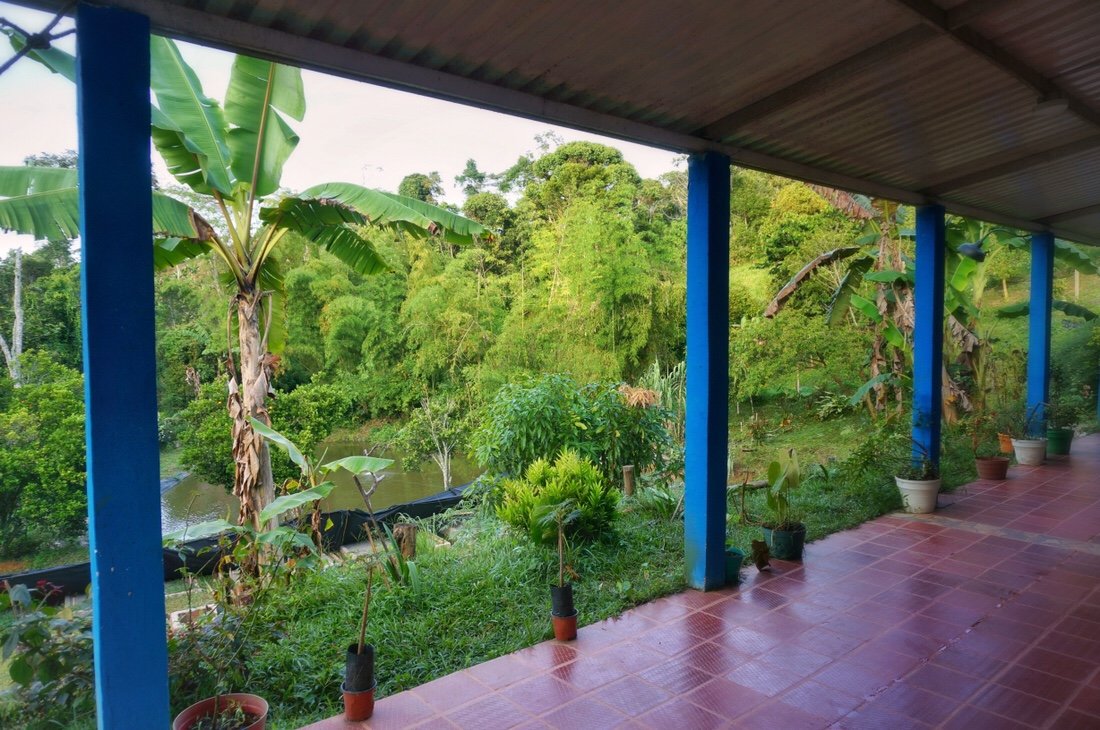 They fed us sugarcane, tangerines, and fish, all grown on site. I do still occasionally eat fish, so it was a real treat to have whole fish, stuffed with vegetables inside, and cooked in a banana leaf.
They fed us sugarcane, tangerines, and fish, all grown on site. I do still occasionally eat fish, so it was a real treat to have whole fish, stuffed with vegetables inside, and cooked in a banana leaf.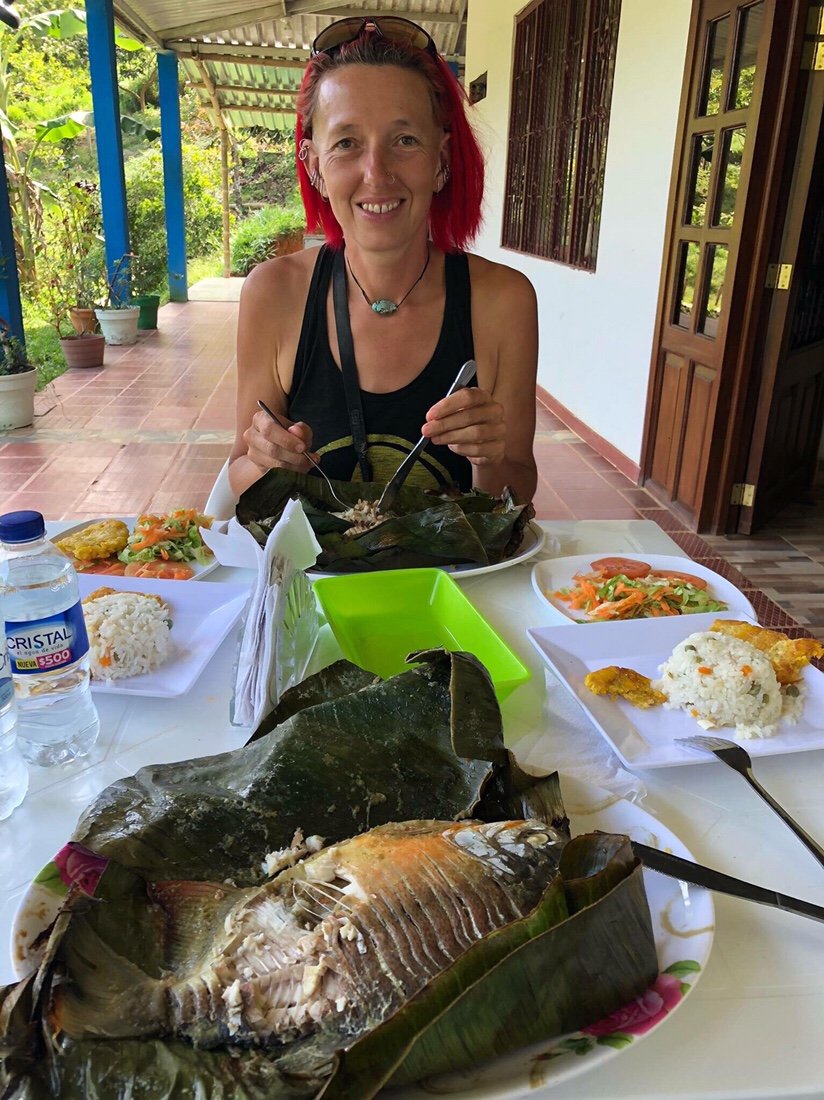 After dinner, we soaked in their fresh water pool and waterfall.
After dinner, we soaked in their fresh water pool and waterfall.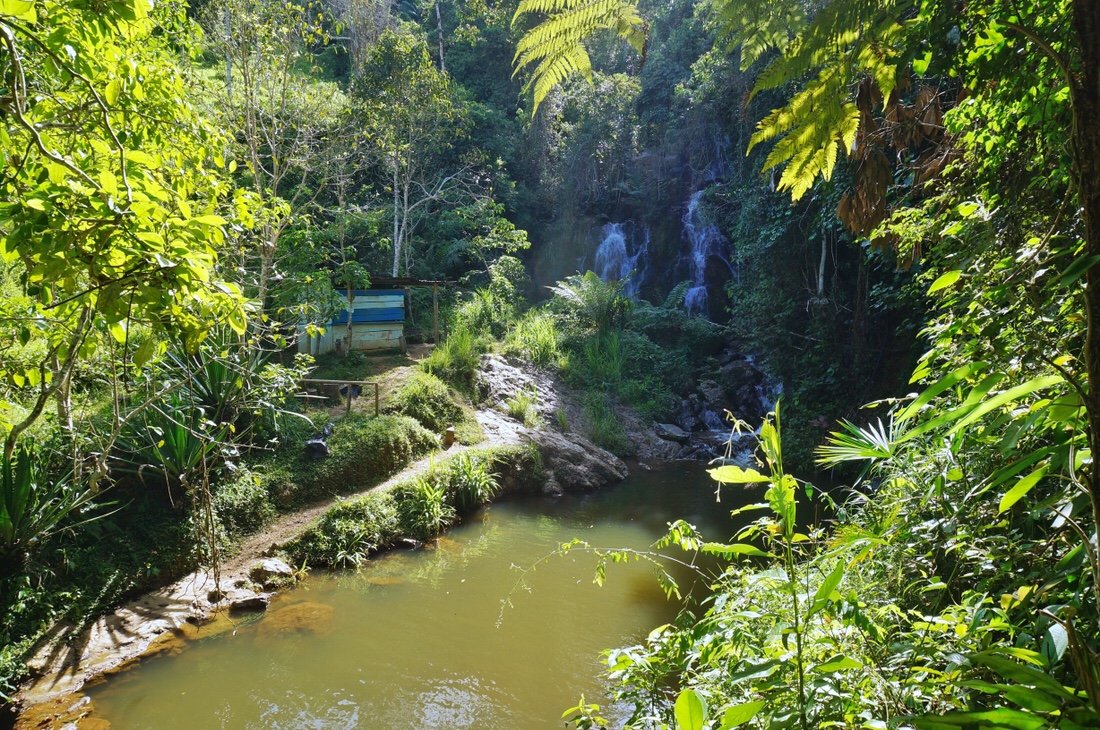
 It was an amazing little place that was surprisingly inexpensive, and a fun change from just another hotel.
It was an amazing little place that was surprisingly inexpensive, and a fun change from just another hotel. We left early the next morning. The hills were all covered with coffee trees, up the steep slopes, and all the way down to the road.
We left early the next morning. The hills were all covered with coffee trees, up the steep slopes, and all the way down to the road.
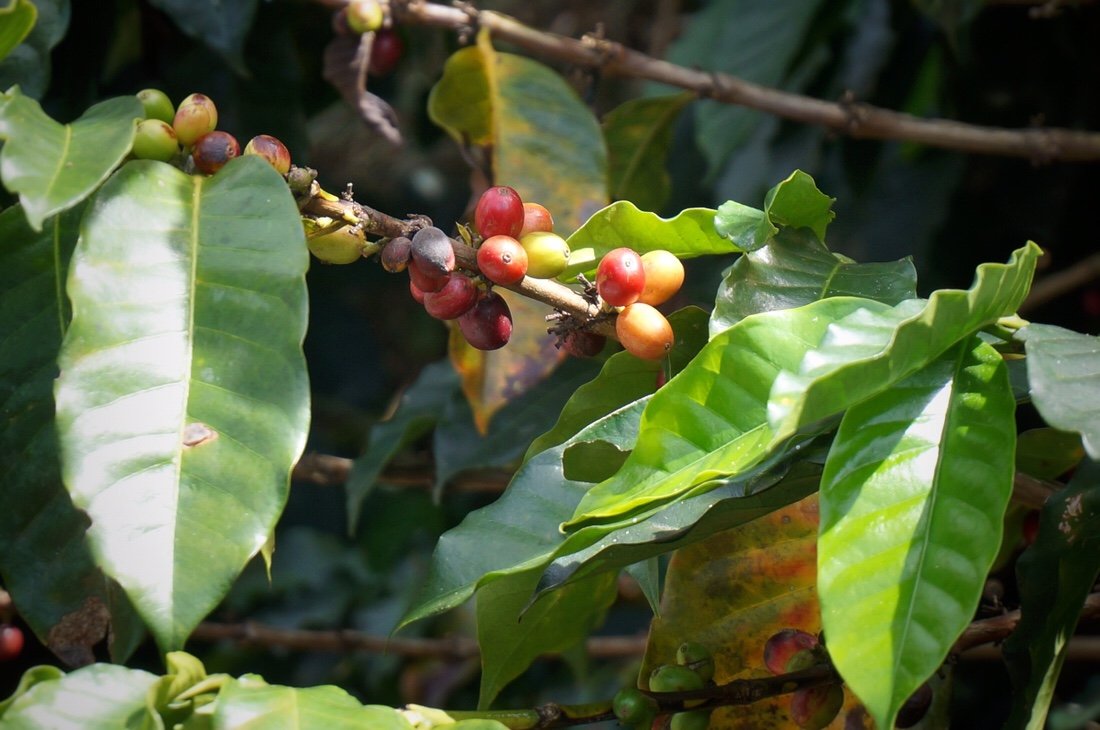
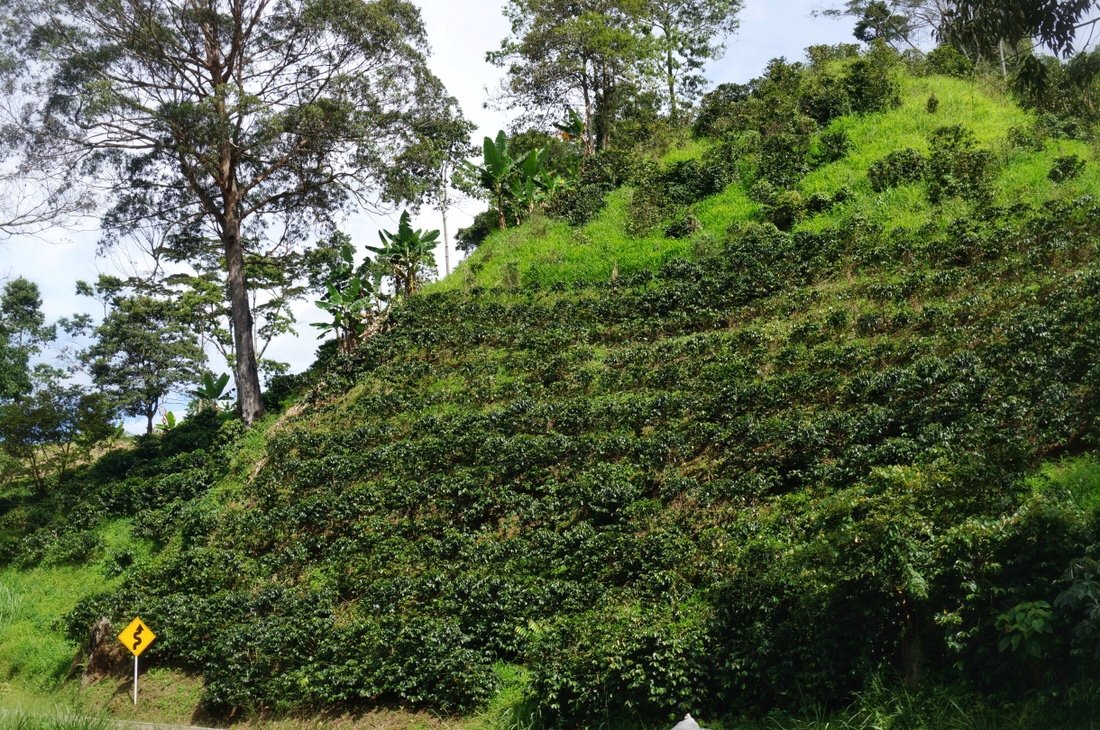 We made another short day of it, stopping early in the town of Libano, where I really began to notice just how many bicycles and motorcycles there are, everywhere we've been in Colombia. Seeing all the motorcycles here reminds me a lot of all the vespas in Italy.
We made another short day of it, stopping early in the town of Libano, where I really began to notice just how many bicycles and motorcycles there are, everywhere we've been in Colombia. Seeing all the motorcycles here reminds me a lot of all the vespas in Italy.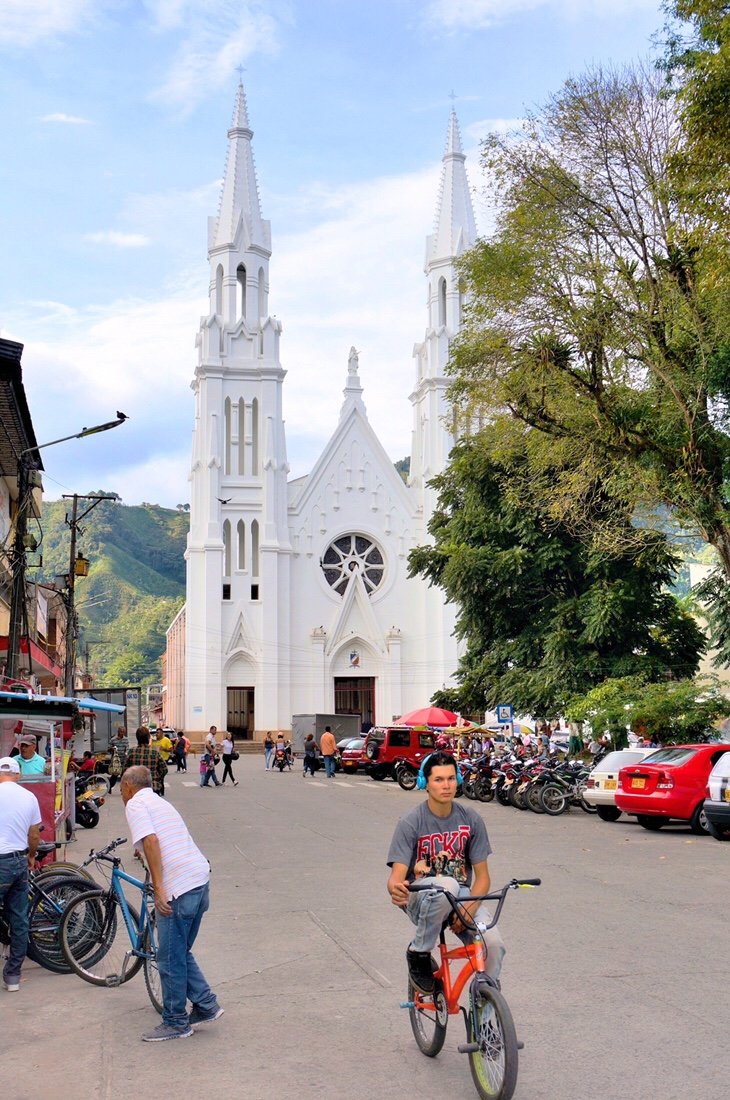 We haven't found much espresso since we left Bogota, but Colombian coffee, most often referred to as "cafe tinto" is pretty good.
We haven't found much espresso since we left Bogota, but Colombian coffee, most often referred to as "cafe tinto" is pretty good.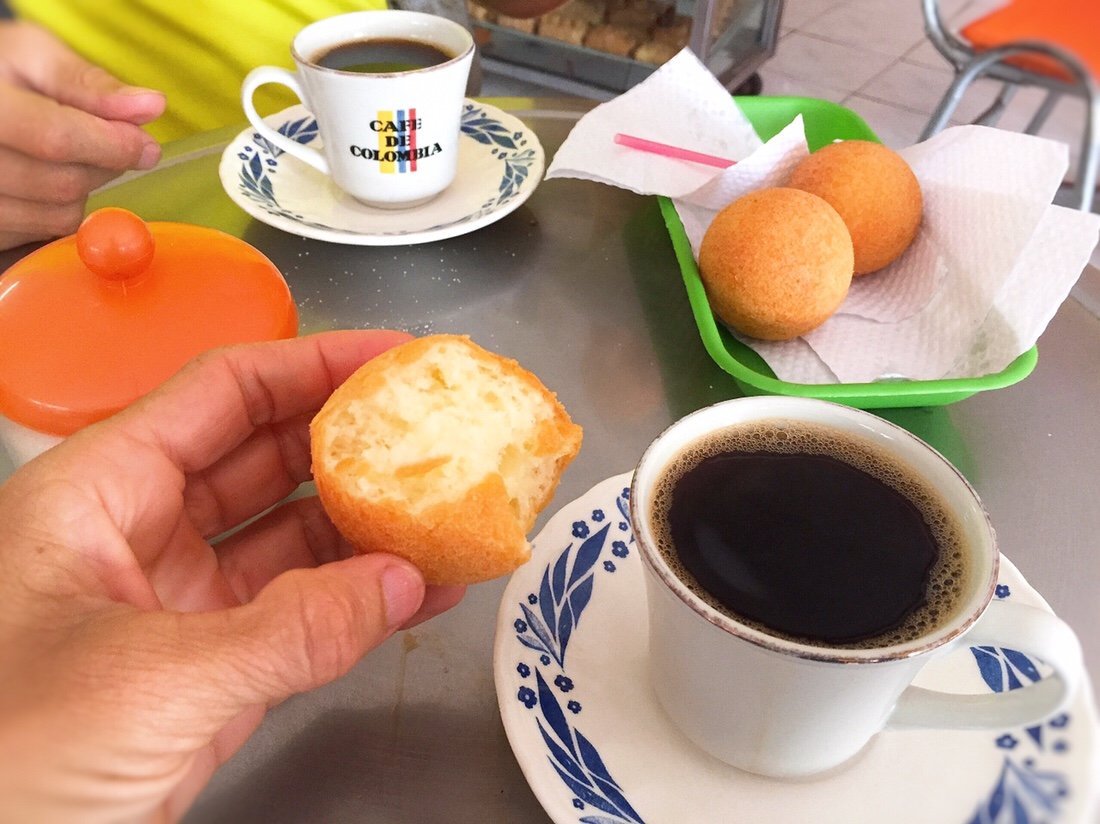
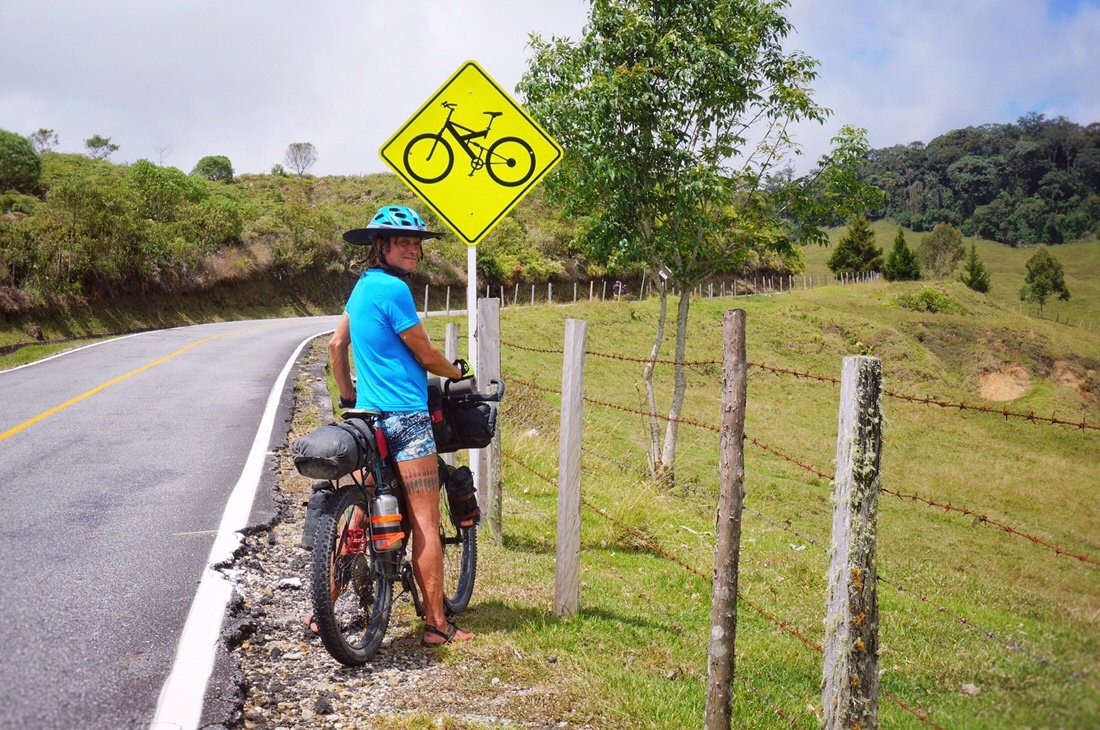 As we climbed up to Murillo, the last town before Nevado Ruiz, coffee plants gave way to more grazing land for cattle, and other plant crops like "tree tomato" and "lulo".
As we climbed up to Murillo, the last town before Nevado Ruiz, coffee plants gave way to more grazing land for cattle, and other plant crops like "tree tomato" and "lulo".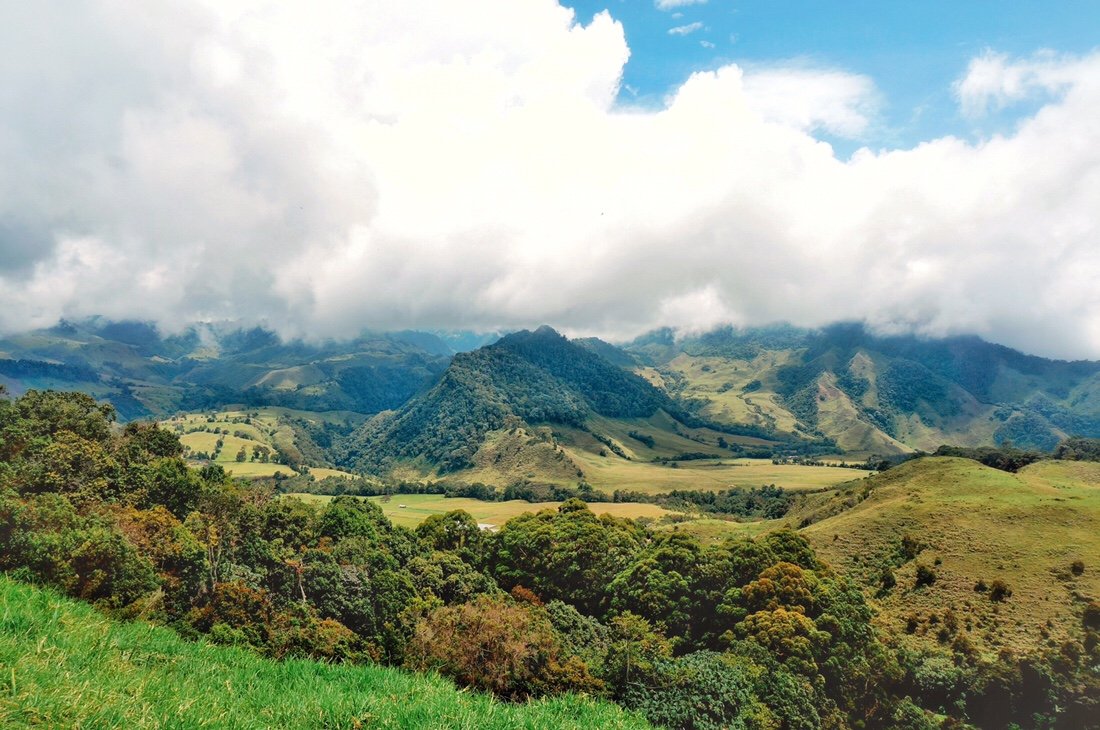 Tree tomato and lulo are both solanaceous plants in the nightshade family, like tomatoes, eggplant, and potatoes.Tree tomato (below) is usually prepared as a juice, but is also eaten fresh.
Tree tomato and lulo are both solanaceous plants in the nightshade family, like tomatoes, eggplant, and potatoes.Tree tomato (below) is usually prepared as a juice, but is also eaten fresh. Lulo (below) is usually prepared as a juice. It is also used as an ice cream flavor, and eaten fresh.
Lulo (below) is usually prepared as a juice. It is also used as an ice cream flavor, and eaten fresh.

 The town of Murillo was a nice surprise. It's very small and not fancy, but all the building are colorfully painted, even the toys in the park were very festive.
The town of Murillo was a nice surprise. It's very small and not fancy, but all the building are colorfully painted, even the toys in the park were very festive.

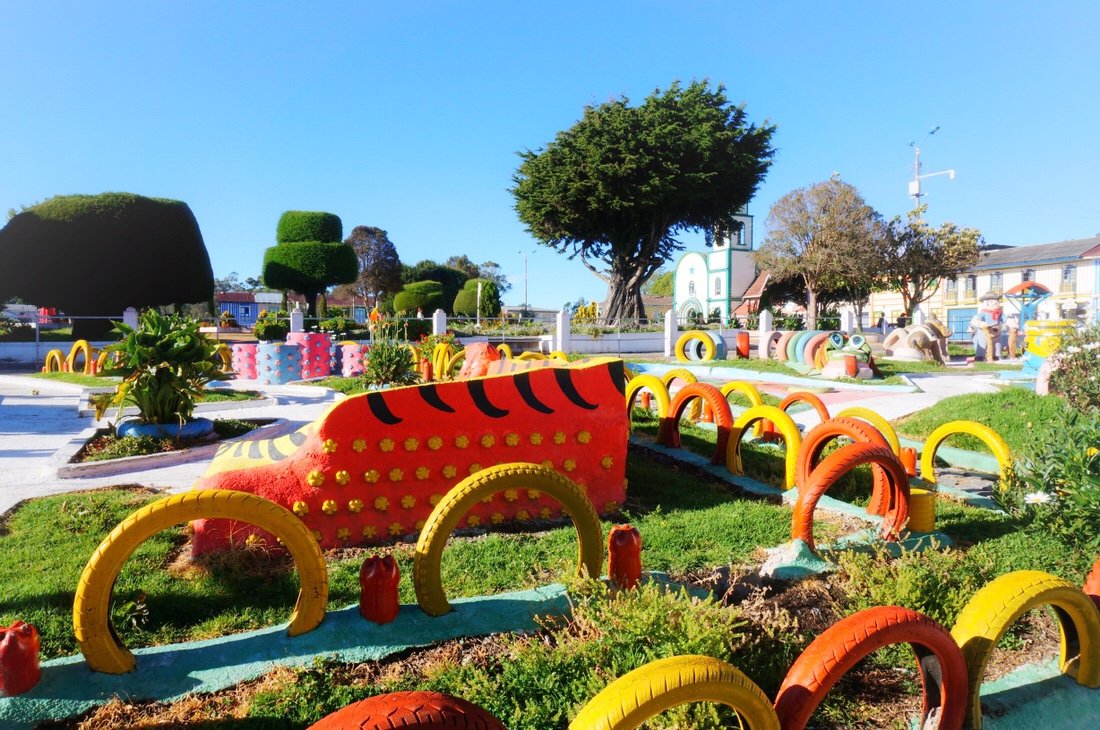 We spent a couple of days in Murillo, resting, hanging out in the panaderias in the morning for coffee, and trying Agua panela, before continuing on to Nevado Ruiz._____________________You can sign up to receive The Redheaded Nomad’s blog posts in your email inbox; sign up at the bottom of any page on my website: theredheadednomad.comFor more frequent updates, follow me on Instagram at: instagram.com/theredheadednomadYou can also find me on Facebook at: facebook.com/redheadednomad_____________________
We spent a couple of days in Murillo, resting, hanging out in the panaderias in the morning for coffee, and trying Agua panela, before continuing on to Nevado Ruiz._____________________You can sign up to receive The Redheaded Nomad’s blog posts in your email inbox; sign up at the bottom of any page on my website: theredheadednomad.comFor more frequent updates, follow me on Instagram at: instagram.com/theredheadednomadYou can also find me on Facebook at: facebook.com/redheadednomad_____________________

